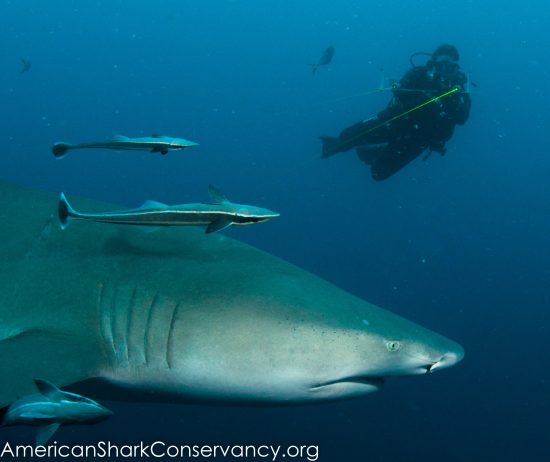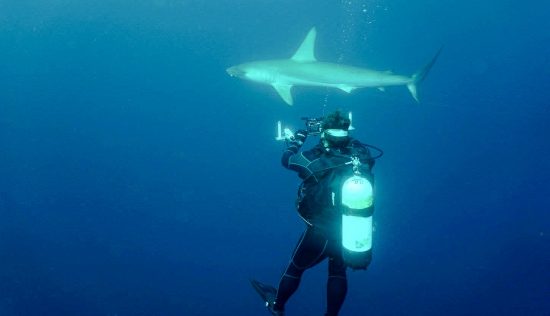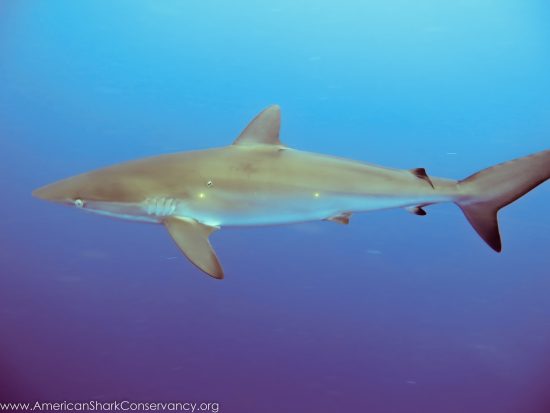






Have you ever had one of those days when just about everything
goes wrong? Mine started out breaking one of my own rules: not packing my own
dive gear bag. “What do you mean you can’t find my gloves?” I asked my dive
buddy, who also happens to be my husband and an experienced dive instructor, as
the boat pulled away from the dock. He riffled through my dive bag and shook
his head. Who forgets their dive gloves? I really didn’t want to break my other
rule of always wearing gloves when diving with sharks. My hands are usually
busy holding a camera or some other equipment but I still don’t like how much
they resemble a chunk of dead fish sticking out the end of a black wetsuit. The
dive master tossed me an extra pair of gloves. I smiled
sheepishly.
Murphy's Law states that whatever can go wrong, will go wrong and its force was strong that morning! I hit the snooze button too many times so we scrambled to get all our dive, research and photography equipment loaded.
We usually pack our own gear bags, double checking with each other with mental
lists, but that morning I realized the lasers on my photogrammetry rig were dead
and I needed a few extra minutes to change batteries so he finished packing my
bag. The lasers are an important part of the camera rig. They project
points of light a specific distance apart onto the side of the shark so that we
can later analyze the pictures to determine its body length and age class. This
is an integral part of a long-term monitoring project run by our organization,
the American Shark Conservancy, to
better understand the seasonality of shark assemblages on the east coast of
Florida using standardized methods. But you can’t really collect the data when
your lasers are dead. And we hadn't gotten far from home when we had to turn back to get my husband's fins.
Finally, motoring
towards the Palm Beach inlet and out to the offshore waters of the Atlantic
Ocean, I set up my dive gear by muscle memory, as my mind spun. What depth
should we start the dive? Will the currents push us west? How is the
visibility? Has the bait thawed? Where I put those zip ties? I dug through my
tool box to no avail and with a sigh, I pictured the new bag of zip ties
sitting on the counter by the door at home, right where we left them. One thing
I have learned as a field biologist is to improvise. A few twist ties and a
spare shackle secured the acoustic monitor to the bait crate rope as we
approached the GPS point for the first dive of the day. The volunteers got the
nearly-frozen barracuda out of the cooler and of course, there's no machete. My
cheeks warmed with frustration but I produced my little dive knife and started
sawing the fish into even chunks.
I wondered for a brief second if it might be better to turn
around and try another day, especially when we are about to get in the water
with apex predators. My stubbornness pushed that thought away, the work needed
to be done. Over my shoulder, I heard an o-ring blow on a tank and a diver
getting sick overboard. The captain announced that we are at the spot so the
bait crate went overboard and sunk to the rope’s length of 50 feet while the
buoy bobbed at the surface. The tank's o-ring was quickly replaced and everyone
slipped into their gear, even the guy that was sick. I snuggled into my trusty Mares Dragon BCD,
checked that my air was on and stood up, barely feeling the weight of the steel
tank. Where was the data sheet? Opps, it was in my backpack so I waddled to the
bow, all kitted up, dug out the clipboard and explained to the captain how to
fill it out for the 5th time while the other divers jumped off
the back and descended on the crate line. I grabbed my camera, found the buoy
through a stress-fogged mask, and took a giant leap off the dive platform.
The
chilly water slipped down my back and I adjusted my buoyancy to float just
below the crate, cleared my mask, turned on my camera and lasers and took a
slow breath. Like a miracle, everything was working. A shy but large great
hammerhead swam at the edge of the divers and I got some decent side-on shots
for analysis and was surprised by the arrival of the survey’s first male lemon
sharks. I was totally focused on the animals, getting the right pictures,
capturing behaviors, skin abnormalities, whether they were tagged. The stress
of getting to this moment completely melted away and I remembered why I woke up
at 5 am and problem-solved all morning. It is imperative to know more about
these animals because of the pressures they face from things like habitat
degradation and fishing. As a dusky shark swam by with three fishing hooks in
her mouth, I realized we could make a real difference. Back on the boat,
everyone was high-fiving and smiling because we survived Murphy's Law and accomplished our goal. And after the second dive I found my gloves in my
backpack, I promised my husband I'd pack my own gear bag next time.
 Hannah
Hannah 24th April 2017
24th April 2017 201-225 S Ocean Blvd, Palm Beach, FL 33480, USA
201-225 S Ocean Blvd, Palm Beach, FL 33480, USA 

